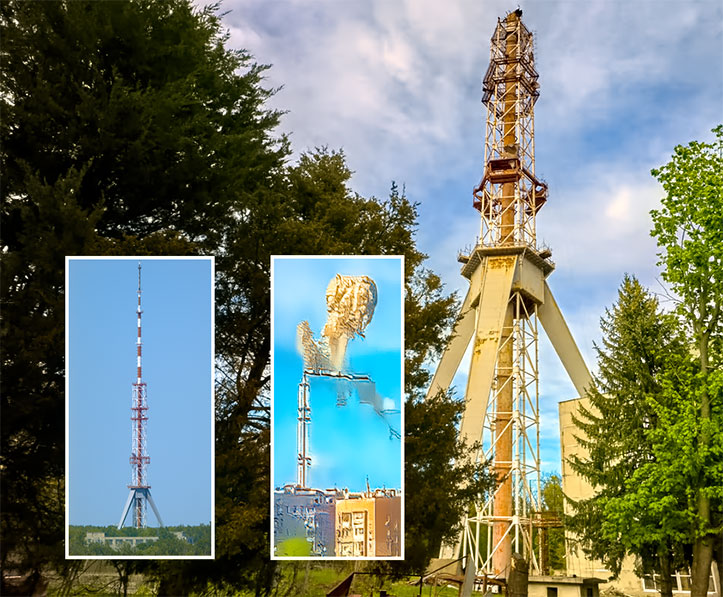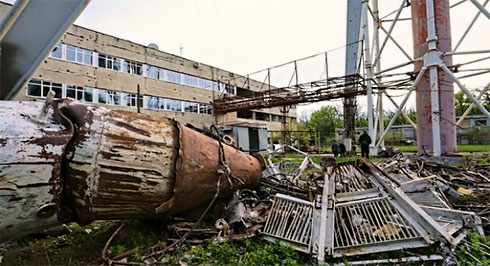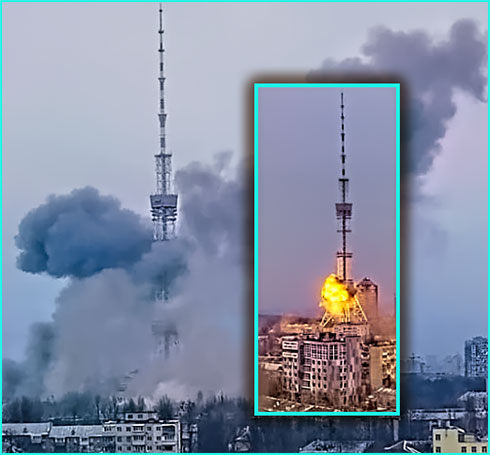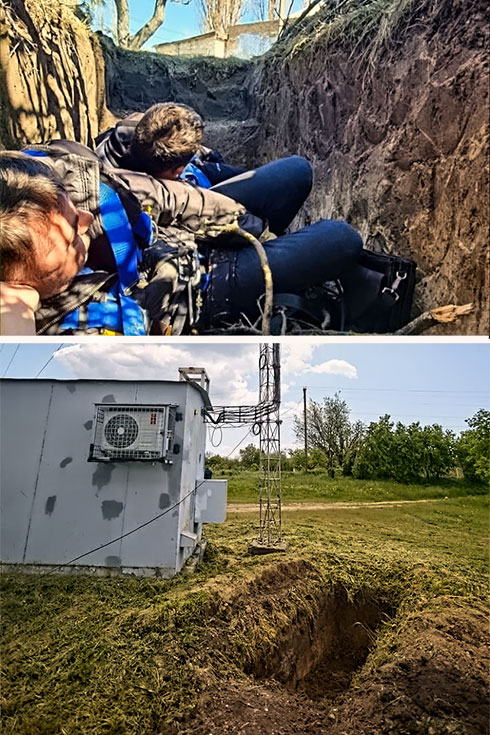
A RUSSIAN missile strike was successful yesterday in toppling the top half of this 790-foot broadcast tower in Ukraine. The conflict has also destroyed a significant portion of cell service in the country, and tower techs must risk their lives to restore it (See photos below).
On March 6, 2022, a Russian fighter jet attacked a television station in Kharkiv, Ukraine, releasing eight 1,100-pound bombs at the station’s 790-foot tower and the adjacent building. Despite substantial damage, the broadcasting infrastructure was quickly repaired, and operations resumed.

Ukrainian communications officials said the tower will not be operational until repairs are made after the war.
However, a strike yesterday by a Russian cruise missile has now destroyed the upper portion of the fifth-tallest tower in Ukraine, achieving the destruction the initial attack did not. Ukrainian authorities said the tower could not be rebuilt until after the war ended.
This latest assault falls into a broader strategy by Russia to debilitate Ukraine’s second-largest city, according to Ukrainian President Volodymyr Zelensky. In a conversation with U.S. President Joe Biden, just moments before the strike, President Zelensky highlighted the severity of the situation. He later described the strike in a nightly address as a stark attempt to terrorize Kharkiv’s residents and disrupt their access to communications and information.
Located only 18 miles from the Russian border, Kharkiv’s proximity makes it highly vulnerable to attacks. The missile that hit the Kharkiv tower has a range of at least 500 miles.
The city, home to 1.3 million people, has suffered especially severe damage to its power infrastructure amidst Russia’s broader campaign against Ukraine’s energy facilities.
The world’s tallest self-supporting steel tower is still standing

ALTHOUGH IT WAS DAMAGED during a missile strike, this 1,263-foot TV tower is still broadcasting. It’s possible its all-welded construction kept it from collapsing.
On March 1, 2022, a Russian missile struck a Kyiv 1,263-foot TV tower, killing five and injuring five others. Although there was considerable damage to the structure, it was rebuilt. It is the tallest structure in the country and the tallest self-supporting steel tower in the world.
The tower is unique in that every section is attached by welding. According to Wikipedia, it took five years to build and was completed in 1973 at a cost of $12 million. With inflation, the cost would be $100 million in 2024.
Tower techs fear for their lives every day

CONTINUOUS STATE OF ALERT AND ADAPTION – Whereas Ukrainian tower techs prior to the war would normally take a break at the base of the tower or in a vehicle, it’s necessary to do so in a trench which also provides limited protection during ongoing battles. In addition, in many cell site locations, a foxhole is an expected job hazard requirement. Photos courtesy: Vodafone Ukraine
In the U.S., tower technicians work in an inherently dangerous environment. In the war-torn landscapes of Ukraine, tower techs also have to brave relentless danger to maintain vital communication links as the Russian invasion enters its third year.
These technicians, ensconced in dugout pits and flanked by the ruins of repeated battles, embody the risks and resilience required to keep Ukraine connected.
Despite many areas being recaptured by Ukrainian forces during counteroffensives, many cities remain a focal point of hostilities, exposing repair crews to constant danger. Each mission to restore service is fraught with the risk of shelling and gunfire, a grim reality for those techs who often find themselves working alongside military units to ensure their safety.
The challenges faced by Ukranian techs are immense. Upon arrival at a site, in addition to their climbing PPE, they must don full protective gear—armor jackets, helmets, and carry first aid kits, alongside the technical equipment needed for repairs.
The threat of land mines adds a grave dimension to their work, necessitating extreme caution with every step taken in and around the repair sites.
Solidarity over competition
In a significant move, the major telecom providers in Ukraine, including Kyivstar along with Vodafone and Lifecell, have set aside competitive drives to cooperate amidst the crisis. This collaboration has been crucial, allowing them to share undamaged infrastructure and resources, ensuring that connectivity remains uninterrupted wherever possible.














